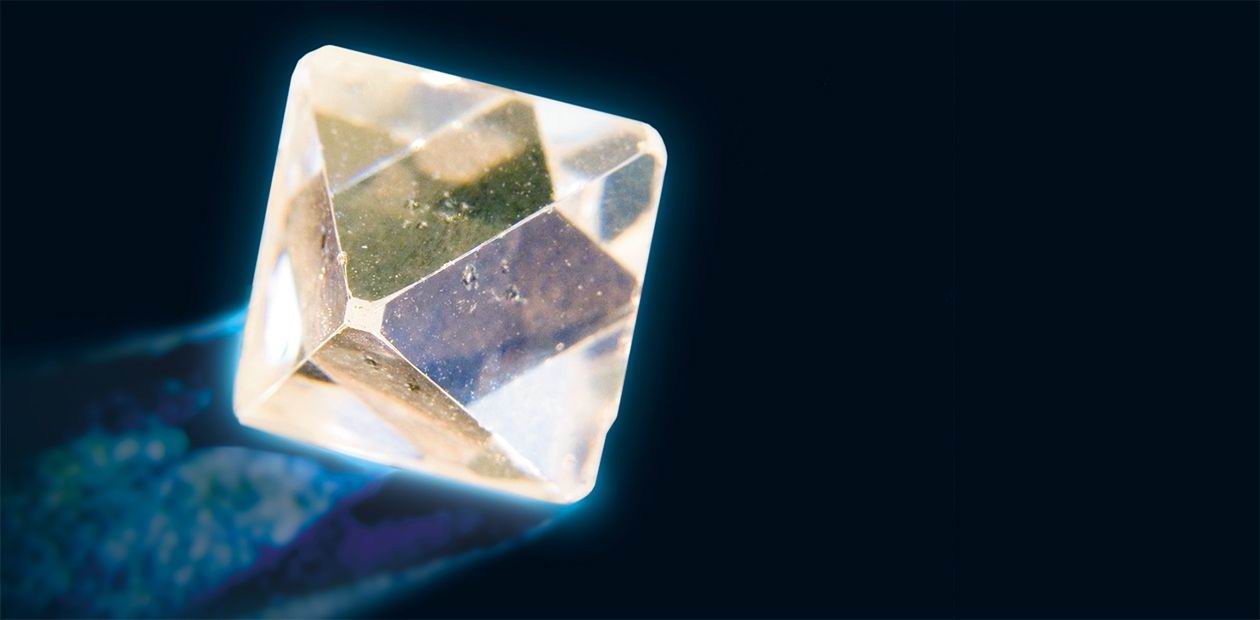Saga about Unrealized Diamonds
We may often hear the words “Diamonds are girls’ best friends…” from a song sang by Marilyn Monroe long ago. And we imagine dazzling iridescent light sparks flashing on ideal faces of the stone set in noble metal… Dollars multiplied by carats. A mineralogist, however, who sees another beauty and utility in the magnificent diamond, considers it as insignificant remains of a beautiful crystal that existed before. At normal lighting, this beauty of the diamond is imperceptible, and not without reason it can be compared with plain fragments of glass
Although we do not consider geologists as enemies of jewelry and of the beautiful in general, we have to admit that during a mineralogical investigation the diamond itself can have an “unenviable lot”. This brings up the following reasonable question: is it really necessary to use for such purposes the rare and expensive mineral? And the answer is: “Yes”. Diamonds are attractive for geologists because they can help to learn much not only about the Earth’s structure and the composition of its component rocks, but also about the evolution on the planetary scale. Strangely enough, the mankind delved into space much farther than into the depth of its home planet, which is like a needle’s prick into the skin of a large apple.
The main sources of diamonds are kimberlites, namely, magmatic rocks that rose from the Earth’s interior and solidified in its crust. Their penetration channel often resembles a tube that is narrowed from top to bottom. That is why the component rocks were called kimberlite tubes. These are, in a sense, ultradeep wells with valuable contents, the nature’s gift.
Diamonds are for-med from carbon at a temperature of about 1000° C and higher and at a pressure of about 40 kbar. The diamond crystal produced from kimberlite contains information about the geological events and processes that occurred in the Earth’s mantle at depths of 150—300 km tens of millions of years ago. The main purpose of present-day investigations of diamonds is to decipher these unique data contained in this rare and wonderful “carrier”.
The investigation of a diamond starts with quite a harmless method — its examination under the microscope. This determines its value for further investigation and the solution algorithm. First, the color, the shape of crystals or their aggregates are determined. These can be polyhedrons: octahedrons, cubes, dodecahedrons, and even more complex rounded shapes.
Various lighting conditions are used to study the internal structure of crystals. They can be examined in normal (day), reflected, oblique, transmitted, and polarized light… The pictures change almost like in a kaleidoscope, and we see more and more unexpected details. With the help of optical microscopy methods, we can learn, to a first approximation, about the life fate of the diamond crystal from very young age to adolescence and on to its old age… or, in scientific language, its ontogeny, associated with its growth and destruction, and often with its dissolution. And the striking beauty of natural diamonds discovered by such an investigation is no less fascinating than that of perfect diamonds.
The luminiscence of diamonds in ultraviolet light is a common phenomenon. The photoluminescence pattern obtained in this case, invisible at daylight, makes it possible to view the diamond’s inner structure. The fact is that the shape of diamond crystals, at each stage of their existence, is reflected, in some way, in the zones and sectors of growth of their faces. The zones and sectors in diamonds can luminesce any light, from a cool blue to a warm red and orange. The dependence of a photoluminescence color on the composition and defects of the diamond structure is not yet completely understood. One can see a more detailed picture of fine zoning of crystals in special oriented cuts and plates made from diamond crystals with the help of a cathodoluminescent attachment to the electronic microscope. Then the surface of the specimen is bombarded with an electron beam, and its luminescence is fixed. The luminescence of diamonds can be excited by X-ray beams: this property of diamonds makes it possible to reject foreign minerals during mining.
The micromorphology of diamonds — a fine sculpture of its surface — is studied in reflected light. By delivering a light beam of a certain wavelength to a diamond face, one can obtain an interference pattern in the form of alternating iridescent bands, the distance between which is used to measure the difference between the relief altitudes. Electronic microscopy is used for more detailed investigations of the surface. The relief on crystal faces can reflect both the final stage of its growth and the so-called post-growth processes, for instance, dissolution processes that could occur in the mantle or as the crystal was transported in the magmatic melt. Owing solely to a high hardness of diamonds, the surface sculpture of their crystals is well preserved during all peripeteia of their life on the Earth’s surface associated with the transfer by water flows. And this period of time can take hundreds of millions of years!
Diamond crystals can have inclusions of various minerals, whose value for researchers is no less than that of diamonds themselves. The minerals-inclusions could form simultaneously with the diamond-host. In this case, they are called syngenetic and, as a rule, their shapes are similar to that of the crystal-host. There are also inclusions that are trapped by the diamond directly from the crystallization medium during the crystal growth. These inclusions are earlier than the diamond itself. The inclusions of high-density crystalline modifications of silica, namely, stishovite and coesite, are the indicators of extremely high temperatures and pressures during the formation of diamonds. The composition of these minerals, which were detected in diamonds quite recently, is similar to that of ordinary quartz, SiO2.
Study of the chemical composition of diamond inclusions and their associations also provides much information about the geological and chemical conditions that existed long ago, as well as about the temperature and pressure parameters. In diamonds, one often finds garnet, olivine, pyroxene, graphite, sulfides, many other minerals, and even gas-liquid inclusions. The inclusions are extracted from diamonds by cleaving, lapping, or sawing of its crystals. Regrettably, one of the best ways to preserve for investigation the inclusions of a diamond is to burn the diamond itself, which burns down easily in ordinary atmosphere at a temperature of 850—1000 degrees. The ashes that remain after the diamond is burned down are investigated to determine its composition.
The age of syngenetic inclusions of the minerals in diamonds and, hence (in the opinion of many researchers) of the diamonds themselves, was determined with the help of the isotopic dating method. The estimate of this age by different researchers ranges from 1.5 to 3.5 billion years. Younger diamonds, whose age is a mere hundreds of millions of years, were also detected. Recently, more attention has been given to the isotopic composition of carbon in diamonds, i. e. to the ratio between the heavy (mantle) isotope С13 and the light (crust) isotope С12. The detection of light isotopes in diamonds typical of organic compounds resulted in a string of hypotheses about the source of these isotopes and discussions about the migration of carbon in the Earth’s mantle and crust at the motion of land and ocean plates. Planetary models of the Earth’s core degassing during its evolution are constructed on the basis of these data. Surprisingly, they are also used in the discussion of the controversial question about the origin — organic or inorganic — of oil and natural gas.
We have mentioned only a small part of the results of investigations of diamonds: thousands of scientific publications are devoted to this theme. It should be noted that as a new method appears, at each new stage of investigation, and with each new result there appear new moot dilemmas. Recall the discussion about the origin of rounded shapes of diamond crystals, which lasted almost a hundred years as to whether the rounded shapes resulted from the growth process or, on the contrary, from dissolution? Novosibirsk geologists seem to have settled this issue: they have obtained most natural shapes of diamonds in experiments on their dissolution. This is, however, another topic and a theme for a new publication.
Photos by the courtesy of the author. Photo on the first page was made by V. Korotkoruchko









